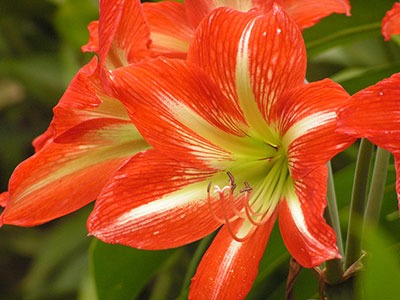Here are some of the most dangerous plants and flowers that cat owners should never keep around the house. I highly recommend ensuring your cat does not go near these flowers as could make them very sick.
1. Lilies
There are lilies that will only cause minor mouth irritation when ingested. These include:
- Calla lilies
- Peace lilies
- Peruvian lilies
Signs your cat has ingested lilies includes drooling, pawing at the mouth, foaming on the mouth, vomiting and in some rare cases difficulty in breathing due to inflammation.

Lilies that are extremely poisonous to cats are those from the Lilium or Hemerocallis species:
- Easter lilies
- Tiger lilies
- Asiatic hybrid lilies
- Daylilies
- Japanese Show lilies
- Wood lilies
- Red lilies
- Rubrum lilies
- Stargazer lilies
- Western lilies
All parts of these flowers are highly toxic to cats. Eating two or three petals or leaves— even just pollen from this plant—can cause cats to suffer severe kidney failure.
Signs of ingestion include vomiting, drooling, excessive thirst or urination, lethargy and halitosis (bad breath).
Another kind of lily is Lily of the valley (also known as May bells, Our lady’s tears or Mary’s tears). It is an extremely poisonous kind of lily that’s part of the Convallaria species. It is known to cause irregular heart beat (or arrthymia) and also death to both cats and dogs.
If you ever see or even suspect your cat to have consumed any of the above mentioned plants, bring them to the vet immediately. Be sure to tell the veterinarian the exact kind of plant your cat ingested so they can give the right treatment.
2. Daffodils
The yellow and white Daffodils contain lycorine, which is an alkaloid that can cause severe vomiting. The outer layer of the plant’s bulbs also has crystals that can cause severe irritation.
Signs of ingestion (of any part of the plant) include:
- Vomiting
- Drooling
- Diarrhea
- Abdominal pain
- Cardiac arrhythmia (irregular heartbeat)
- Respiratory depression

3. Amaryllis
Amaryllis produce beautiful bell-shaped flowers, making them a popular gift. But, keep in mind that they’re poisonous and it’s not just their
flowers. The stalks and bulbs of the Amaryllis plant also contain the same toxic substance that pose a danger to the feline community:
phenanthridine. All parts of the plant should be off limits to cats and should never be given as a gift to cat owners.
Signs of ingestion include:
- Vomiting,
- Tremors
- Changes in blood pressure
Amaryllis aren’t just a popular gift, they’re also a poisonous one. The stalks, flowers and bulbs contain phenanthridine alkaloids which are toxic to cats. The highest proportion is in the bulbs. Eating amaryllis can cause vomiting, blood pressure fluctuations, tremors and seizures.

4. Chrysanthemums
Chrysanthemums are traditional garden plants usually popular during fall. Although they’re not really deadly, they do contain pyrethrins, which are the main component of flea and tick
medications and are especially toxic to cats.
Signs of ingestion include:
- Vomiting
- Diarrhea
- Lack of appetite

5. Hyacinths
The most dangerous part of the the Hyacinth plant is the bulbs. It contains the highest concentration of oxalic acid, which is very poisonous.
Signs of ingestion include:
- Vomiting
- Drooling
- Diarrhea

6. Tulips
Tulips are one of the most popular flowers, but unfortunately, their bulbs contain tulipalin A and tulipalin B, which are toxic to cats.
Signs of ingestions include:
- Vomiting
- Diarrhea
- Depression

7. Iris and gladioli
Iris and gladioli both belong to the Iridaceae family and are actually toxic to all animals. The most poisonous parts being the bulbs, rhizome and rootstock, but also containing poisonous substances on its leaves.
Signs of ingestion include:
- Drooling
- Diarrhea
- Vomiting
- Lethargy

8. Widow’s Thrill
Widow’s thrill, also known as Kalanchoe, contain toxic cardiac glyclosides which are very poisonous to cats even in small amounts. Symptoms usually occur within a few hours of ingestion.
Signs include:
- Drooling
- Depression
- Diarrhea
- Vomiting
- Heart problems (rare)

9. Foxglove
Foxglove, scientifically known as Digitalis purpurea, contain both cardiac glyclosides and steroidal saponins. Cardiac glycosides are responsible for the more extreme toxic effect of the
plant which causes heart problems. Cardiac glycoside toxicity symptoms also progress very quickly, so recognizing its early signs is crucial in
order for the treatment to be given on time.
Signs of ingestion include:
- Vomiting
- Diarrhea
- Muscle weakness
If you suspect your cat to have interacted with or ingested foxglove, bring him immediately to the vet because coma and death can occur without warning.

10. Cyclamen
Cyclamen, also known as sowbread, is a popular houseplant that contains saponins. It is toxic to both cats and dogs and can be fatal when consumed in large amounts.
Signs of ingestion include:
- Vomiting
- Drooling
- Seizures
- Diarrhea
- Abnormal heart rate

